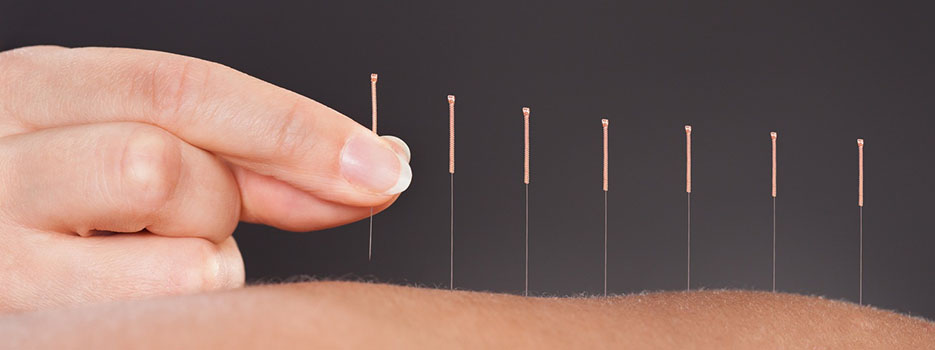Are you dealing with chronic pain? Whether you’re dealing with ongoing aches, pains, stiffness and tightness of the muscles in your neck, back, arms or legs, intramuscular stimulation (IMS), also known as Trigger Point Needling, is an effective treatment. During an IMS appointment, we will discuss your condition and symptoms and perform a thorough assessment to determine the proper IMS treatment protocol.

If you’re ready to try intramuscular stimulation therapy, contact us today to book your appointment.
What is intramuscular stimulation (IMS)?
From the field of acupuncture grew IMS also known as trigger point needling. It incorporates Western medicine’s view on the neurophysiology of pain. IMS therapy takes thin needles, the same as those used in acupuncture, and inserts them into the knots or trigger points of the tight muscles that are causing the pain and dysfunction. This dry needling technique calms the nerves that supply those muscle groups and in turn, the muscles relax and are not as irritable or sensitive. This ultimately restores the muscle’s function and relieves your pain.
How does intramuscular stimulation therapy work?
IMS therapy works by addressing the root cause of musculoskeletal pain. Here’s how:
- Targeting Trigger Points: The needles are inserted into trigger points — tight bands or knots within the muscle that can cause pain and restrict movement.
- Releasing Muscle Tension: The insertion of the needle helps release the tension in these trigger points, leading to reduced pain and improved muscle function.
- Stimulating Natural Healing: The needling process stimulates the body’s natural healing response, promoting increased blood flow, reducing inflammation, and accelerating tissue repair.
- Restoring Proper Nerve Function: The presence of the needle into the affected muscle influences the innervating nerve and improves the ability of the nerve to function normally.
What conditions can IMS therapy treat?
IMS therapy is an incredibly effective treatment used to relieve all sorts of issues including chronic pain, which may be difficult to diagnose. Our clients may have had x-rays, CT scans, or other tests performed with no sign of a problem. They often find that our IMS treatment is the only thing that provides pain relief.
Those clients who suffer from the following conditions can greatly benefit from intramuscular stimulation:
- Arthritis
- Headaches or migraines
- Back pain
- Whiplash
- Neck pain
- Nerve impingement (sciatica, carpal tunnel syndrome)
- Rotator Cuff issues
- Tendonitis, bursitis, or plantar fasciitis
- TMJ
- Tennis elbow
Wondering if IMS therapy is right for your painful condition or injury? Contact us today and our team will be happy to help!
Intramuscular Stimulation Therapy Benefits
Clients who undergo dry needling treatment at Summit Physiotherapy often experience:
- Significant relief from chronic and acute pain.
- Enhanced range of motion and flexibility.
- Accelerated healing and recovery from injuries.
- Better physical performance and function.
IMS vs Acupuncture
Both acupuncture and intramuscular stimulation focus on the insertion of needles into precise areas of the body to increase the body’s natural healing mechanisms. IMS treats specific areas of the body at their source of the pain as a means to loosen the knots so muscles can resume proper functioning. Needles are inserted for a few seconds or a few minutes, and sometimes the therapist will slightly move the needle to stimulate the muscle.
For more information on IMS vs Acupuncture, visit our blog to learn more.
Find An Intramuscular Stimulation Specialist Near You
Frequently Asked Questions
Do IMS treatments hurt?
Regarding IMS treatments being painful or “hurting,” it’s important to clarify that the discomfort the client feels is not from the needles themselves, but from the muscle’s response to the needles. The discomfort is from the muscle tension caused by the presence of the needle in the muscle. The muscle tension experienced can be very mild to the point where it is barely noticeable, but it can also be quite significant where it can feel like a ‘charlie-horse’.
However, not every needle will be uncomfortable. Most commonly the amount of discomfort felt is usually no more than the same sensation as getting a deep tissue massage.
Are there any side effects of IMS treatments?
The common side effect of IMS treatments is the feeling of tightness and stiffness after the session. This can sometimes be immediately after the treatment or it can be felt later that day or the next day. In most cases the stiffness doesn’t last longer than a couple of days. The stiffness felt the next day(s) is similar to that of post-workout stiffness. After a day or two of feeling stiff, the client should experience a degree of relief from their muscle tension and feel more loose and less tight than before the treatment.
Less common can be feelings of nausea or light-headedness immediately after the sessions which last for usually only minutes at most.
Is IMS therapy safe?
Yes, when performed by trained professionals, IMS Therapy & Dry Needling is considered safe. Our therapists are highly skilled, trained and experienced in administering this technique, ensuring your safety throughout the process.
How many IMS treatments will I need before my pain goes away?
Usually we recommend 3-4 IMS sessions before you should feel a noticeable difference. However, on average and depending on the issue, it can take about 7-8 IMS sessions.
It is always difficult to use a blanket statement on how many IMS treatments are needed as so many different conditions and injuries can benefit from IMS. Some conditions are acute and some are chronic and each individual body heals at their own pace.
Is IMS therapy covered by most health insurance plans?
IMS therapy is considered to be a part of physiotherapy, so if your plan covers physiotherapy, then it should also cover IMS therapy.
Visit our therapy fees page for more information about the cost of our physiotherapy services.
How do I know if IMS therapy is right for me?
IMS therapy can be used on anyone for pretty much any condition, it will just work better for certain conditions than others. You won’t really know if IMS therapy is right for you until a physiotherapist assesses you to determine if you’re an ideal candidate. However, IMS therapy is usually best for people that have “Neuropathic Pain,” and that can only be determined by an IMS practitioner.
Generally, IMS therapy works well with people who have chronic pain, whiplash, chronic muscle tension, tendonitis or tendinopathies, sciatica or pinched nerves, and muscle strains that aren’t healing in a timely manner.
Please note: People with blood clotting disorders or anyone on blood thinners should get permission from their doctors first.
Who isn’t suitable for IMS therapy?
IMS therapy is a highly effective treatment, but it’s not suitable for everyone. Here are some conditions and situations where IMS therapy is not recommended:
- Acute injuries that are only days to weeks old.
- Conditions that do not involve neuropathy, in which the nerve does not play a role in the client’s issue.
- Individuals with blood clotting disorders (need permission from the client’s physician).
- For people who are unable to understand what is involved (too young, language barrier, reduced mental capacity).
- Women in the early stages of pregnancy.
- If an infection is present local to the area of needling.
Are you interested in trying IMS therapy?
For more information, or to book your consultation, call us today or book an appointment online.

